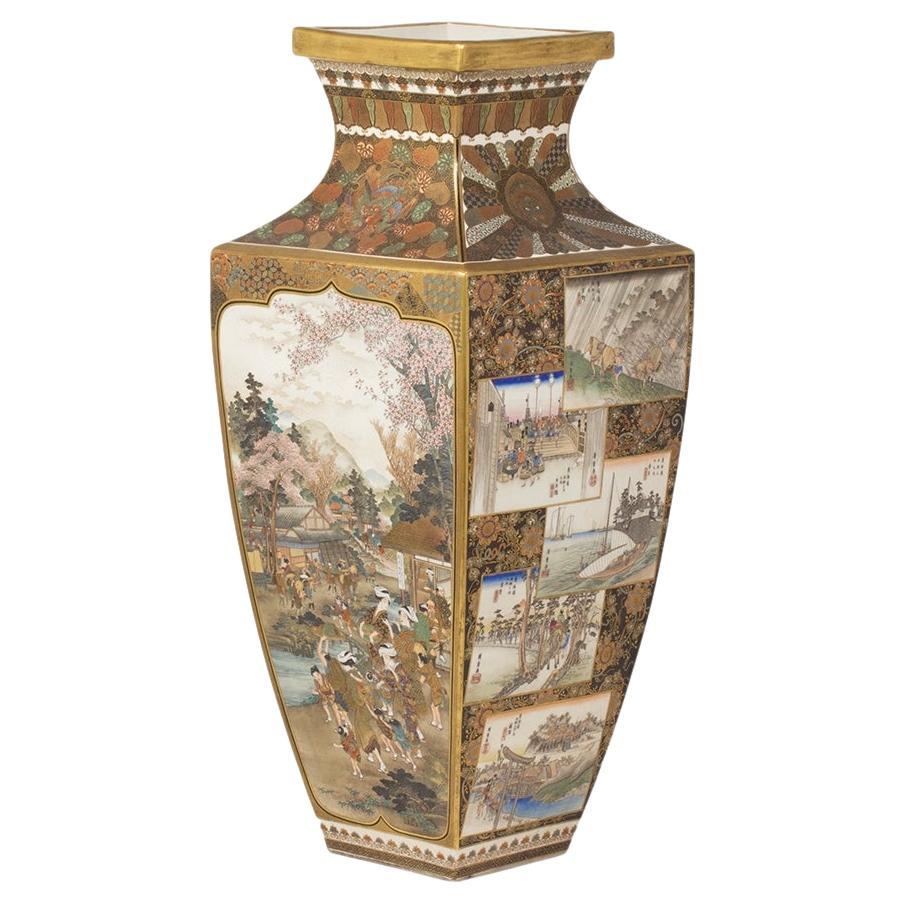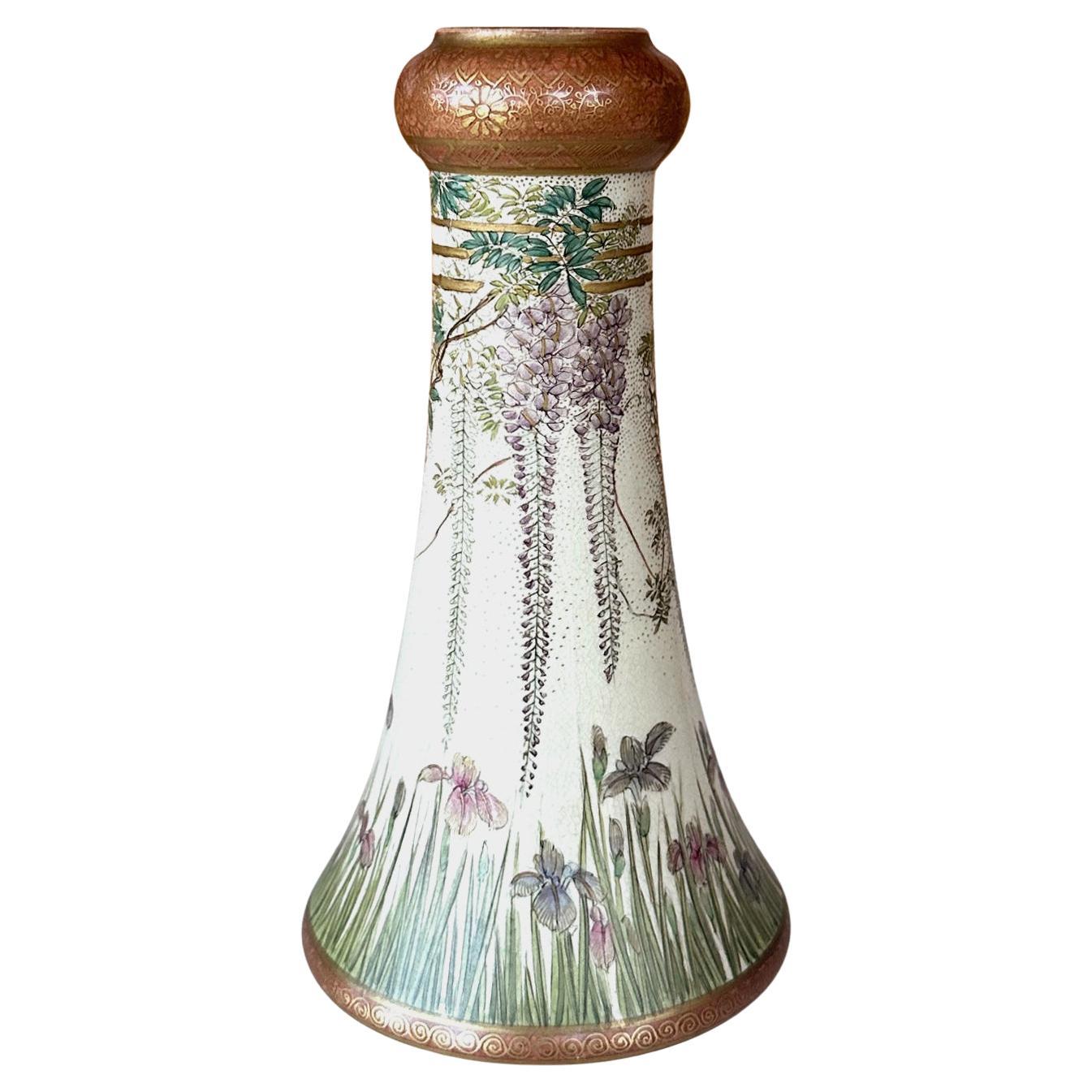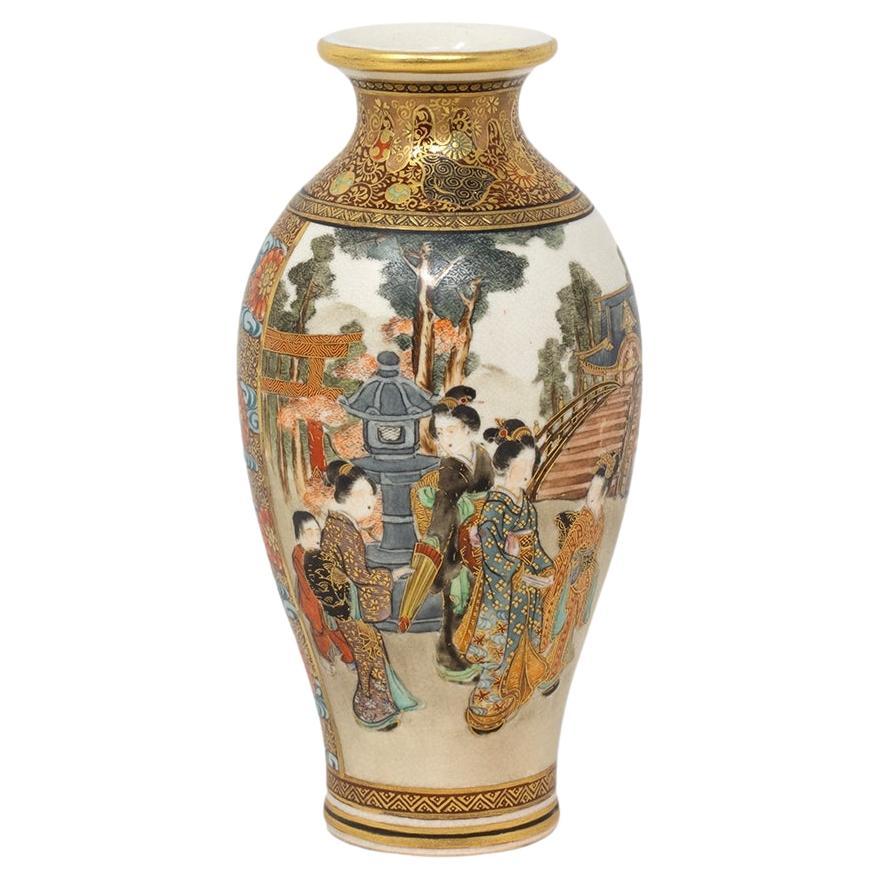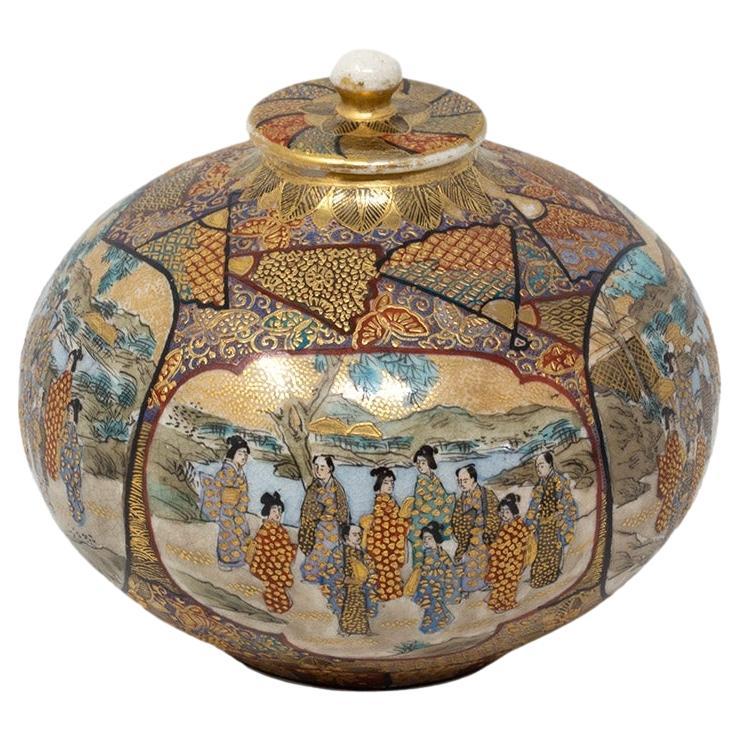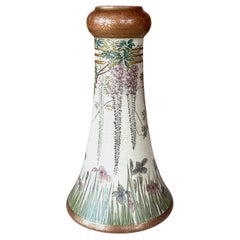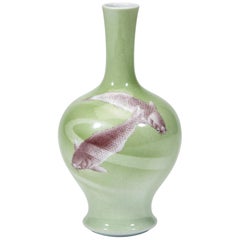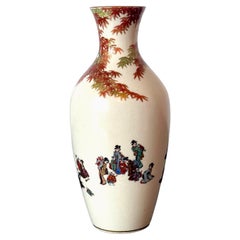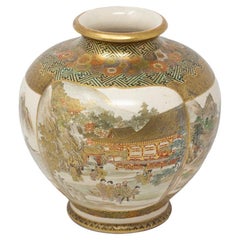Items Similar to Fine Japanese Satsuma Vase by Ryozan Okamoto for Yasuda Company Meiji Period
Want more images or videos?
Request additional images or videos from the seller
1 of 21
Fine Japanese Satsuma Vase by Ryozan Okamoto for Yasuda Company Meiji Period
About the Item
A finely decorated Japanese satsuma ceramic vase by Ryozan Okamoto (c.1820s-1910s) for Yasuda. Ryozan is the head artist working for Yasuda company, a Japanese ceramic makers and dealers established in Kyoto in 1896 by brothers, Gensei and Yoshizaburo Yasida. Born Nakamura Tatsunosuke, Ryozan was a student of the famous potter Nishimura Zengoro who died in 1851, when Tatsunosuke adopted the name “Okatomo Ryozan”. He went on to lead the Yasuda company and became one of the greatest artists in satsuma ware.
The vase is dated 1900s and it is one of the finest satsuma pieces we have handled. The quality is considered to be at the pinnacle of Ryozan's artistry.
The vase was decorated in two large panels of different themes, separated by wide bands in red with gilt scrolls and smaller overlapping rectangular vignettes. One panel depicts an Idyllic Sakura viewing scene set in a beautifully landscaped park with a lake and half-hidden thatch-roofed tea house. Groups of visitors including a large family with children, all dressed in fine kimonos, were leisurely enjoying the cherry blossoms, a snapshot of a fine spring day. On the opposite side, the panel showcases an elaborated painting with a pair of pheasant birds (a male and a female) perched by the water. A large bundle of blooming bushes provided a splendid backdrop, consisting of a variety of flowering chrysanthemum and tall autumn grasses with seeds, swaying in the wind. The workmanship on these panels is superb showcasing the mastery in composition, colors, shading, dimension, motion and the painstaking details to the finest touch.
The shoulder of the vase was partitioned into eight radiating fan-shapes, each is densely decorated with smaller panels of various shape and further infills of either geometrical or floral motifs. The base is marked with insignia of Yasuda Company, the Shimazu Cross below and the artist's name on the right side. The overall glaze shows a fine crackle throughout.
For a vase by Ryozan for Yasuda of different form but similar decorative motifs, see illustration 146 on page 208-209 in "Satsuma: The Romance of Japan" by Louis Lawrence.
- Dimensions:Height: 7.25 in (18.42 cm)Diameter: 6.25 in (15.88 cm)
- Style:Meiji (Of the Period)
- Materials and Techniques:Ceramic,Glazed
- Place of Origin:
- Period:1900-1909
- Date of Manufacture:1896-1910
- Condition:Wear consistent with age and use. Fine condition with light patina and minimal shelf wear around the rim and on the base as shown.
- Seller Location:Atlanta, GA
- Reference Number:1stDibs: LU945041045402
About the Seller
4.9
Platinum Seller
Premium sellers with a 4.7+ rating and 24-hour response times
Established in 2006
1stDibs seller since 2010
542 sales on 1stDibs
Typical response time: <1 hour
- ShippingRetrieving quote...Shipping from: Atlanta, GA
- Return Policy
Authenticity Guarantee
In the unlikely event there’s an issue with an item’s authenticity, contact us within 1 year for a full refund. DetailsMoney-Back Guarantee
If your item is not as described, is damaged in transit, or does not arrive, contact us within 7 days for a full refund. Details24-Hour Cancellation
You have a 24-hour grace period in which to reconsider your purchase, with no questions asked.Vetted Professional Sellers
Our world-class sellers must adhere to strict standards for service and quality, maintaining the integrity of our listings.Price-Match Guarantee
If you find that a seller listed the same item for a lower price elsewhere, we’ll match it.Trusted Global Delivery
Our best-in-class carrier network provides specialized shipping options worldwide, including custom delivery.More From This Seller
View AllFine Japanese Enameled Satsuma Vase by Kinkozan Meiji Period
By Kinkozan
Located in Atlanta, GA
A ceramic satsuma ware vase with very fine surface decoration made by Kinkozan circa 1880-1900s of late Meiji Period. The vase is of an elegant and relatively rare form with a trumpet shape body and the so-called garlic neck and opening. The surface is exquisitely decorated in a floral scheme with gilt and a light jewel-tone enamel. The top part showcases large bundles of wisteria blossom in white and purple, cascading down from a gilt wood trellis...
Category
Antique 1880s Japanese Meiji Ceramics
Materials
Ceramic
Japanese Satsuma Vase Yabu Meizan Meiji
By Yabu Meizan
Located in Atlanta, GA
A Satsuma baluster form vase from the studio of Yabu Meizan (birth name Yabu Masashichi; 1853-1934), who is one of the most celebrated and collectible Satsuma artists from Meiji Peri...
Category
Early 20th Century Japanese Meiji Ceramics
Materials
Ceramic
Fine Japanese Ceramic Vase Makuzu Kozan Meiji Period
By Makuzu Kozan
Located in Atlanta, GA
A Japanese long neck porcelain vase circa 1900-1910s by the studio of Miyagawa Kozan (1842–1916), one of the most established and collected Japanese ceramist from the end of Meiji Period. Commonly known as Makuzu Kozan, which also appears as the signature on his work, his originally birth name was Miyagawa Toranosuke. He was the appointed artist to the Japanese Imperial household and his work was exhibited in many international fairs that the Meiji government participated at the turn of the century.
This vase features an elegant Classic form with a slender neck and slightly flared mouth above a baluster body. It was finely painted with two swimming carps in a copper red underglaze among green ribbons like waves. The background display a brilliant verdant green overall, Around the fish a poetic hazy effect was emphasized for a visual complexity by Fuki-e (the blow painting), an invention in Kozan's studio. The new technical development of chemical colors from the west was embraced circa 1900s in Kozan studio. This empowered the more creative experiments with not only colors, but also concept of dimension, which led Makuzu Kozan's work to become a bridge between East and West aesthetics. This is particularly evident in this vase with the Masterly details of the brush strokes, the expertly employment of gradient of color, and a very realistic and detailed rendering of the fish and their vivid motions.
For two similar examples of Kozan's work with similar carps decoration, see Page 148-149 of the book: Sekai ni Aisa Reta ya Kimono Miyagawa Kozan Makuzu...
Category
Early 20th Century Japanese Meiji Ceramics
Materials
Ceramic
Japanese Miniature Satsuma Vase Yabu Meizan Meiji
By Yabu Meizan
Located in Atlanta, GA
A small Satsuma vase from the studio of Yabu Meizan (birth name Yabu Masashichi; 1853-1934), who is one of the most celebrated and collectible Satsu...
Category
Antique Early 1900s Japanese Meiji Ceramics
Materials
Ceramic
Fine Japanese Ceramic Satsuma Vase by Kinkozan
By Kinkozan
Located in Atlanta, GA
A miniature Japanese ceramic vase from the end of Meiji period circa 1880s- 1910s by Kinkozan (1645-1927). One of the largest studio manufacturers of the export ceramics at the time ...
Category
Early 20th Century Japanese Meiji Ceramics
Materials
Ceramic
Fine Japanese Satsuma Vase with Superb Decoration by Seikozan
Located in Atlanta, GA
A ceramic vase in tapered square form made by Japanese studio Seikozan circa 1890-1910s (late Meiji Period). One of the many artist studios that specialized in satsuma ware, Seikozan...
Category
Antique 1880s Japanese Meiji Ceramics
Materials
Ceramic
You May Also Like
Antique Japanese Meiji Period Satsuma Vase by Okamoto Ryozan for Yasuda Company
Located in Newark, England
MUSEUM QUALITY SATSUMA VASE BY OKAMOTO RYOZAN
From our Japanese Satsuma collection, we are absolutely delighted to bring to market this exceptional Japanese Satsuma Vase by Okamoto...
Category
Antique Early 1900s Japanese Meiji Ceramics
Materials
Ceramic
Japanese Meiji Period Satsuma Vase by Ryokuzan
Located in Newark, England
From our Japanese Satsuma Collection, we are delighted to offer this Japanese Satsuma Vase by Ryokuzan 緑山. The Satsuma vase of ovoid shape with a tapered body, circular foot rim, wai...
Category
Antique Early 1900s Japanese Meiji Ceramics
Materials
Ceramic, Earthenware, Pottery
Japanese Meiji Period Quatrefoil Satsuma Vase by Choshuzan
By Choshuzan
Located in Newark, England
From our Japanese Satsuma Collection, we are delighted to offer this Japanese Quatrefoil Satsuma Vase by Choshuzan. The Satsuma vase of beautiful quatrefoil globular shape with rolle...
Category
Antique Late 19th Century Japanese Meiji Ceramics
Materials
Ceramic, Earthenware, Pottery
Japanese Satsuma Dragon Vase, Meiji Period, c 1900, Japan
By Satsuma
Located in Austin, TX
A fantastic small Japanese Satsuma vase with image of writhing dragons, Meiji Period, circa 1900, Japan.
The vase of elegant baluster form, with a slightly flared foot, slender body...
Category
Antique Early 1900s Japanese Meiji Ceramics
Materials
Ceramic, Porcelain, Pottery, Stoneware, Hardwood
Japanese Meiji Period Satsuma Koro
By Kinkozan
Located in Newark, England
Bulbous Form
From our Japanese collection, we are delighted to offer this Japanese Meiji Period Satsuma Koro. The Japanese Satsuma Koro of round...
Category
Antique Early 1900s Japanese Meiji Ceramics
Materials
Ceramic, Earthenware, Pottery
Japanese Earthenware Meiji Period Satsuma Iris Vase by Ryuzan
Located in Newark, England
Meiji Period (1868-1912)
From our Japanese collection, we are delighted to offer this Japanese Satsuma Iris Vase Painted by Ryuzan. The Japanese Satsuma vase of tall tapered form features a circular rolled foot rim, slightly pinched base with a tapered body and slightly bulbous opening. The vase is decorated with a central continuous band of bright iris flowers with various shades of green to the stems and beautiful violet petals. The central band is framed by greek key borders and honeycomb geometric patterns to the top and bottom. The vase is signed to the base Ryuzan 龍山 and dates to the Meiji Period (1868-1912) and the late 19th century circa 1895.
Satsuma ware is a type of earthenware pottery originating from the Satsuma province in Southern Kyushu, Japan’s third largest island.
Meiji Period was an era of Japanese history that spanned from 1868 to 1912. It was the first half of the Empire of Japan, when the Japanese people began to build a paradigm of a modern, industrialised nation state and emergent great power, influenced by Western countries and aesthetics. As a result of radically different ideas, the changes to Japan were profound and it affected the social structure, politics, economy, military, and foreign relations across the board. The period corresponded to the reign of Emperor Meiji and was preceded by the Keio era and was succeeded by the Taisho era.
Cultural Art during the Meiji Period was of particular interest to the government and they overhauled the art export market which in turn promoted Japanese arts via various world’s fairs, beginning in Vienna at the world fair in 1873. The government heavily funded the fairs and took an active role organising how Japan’s culture was presented to the world including creating a semi-public company named Kiritsu Kosho Kaisha (First Industrial Manufacturing Company). The Kiritsu Kosho Kaisha was used to promote and commercialise exports of Japanese art and established the Hakurankai Jimukyoku (Exhibition Bureau) to maintain quality standards. For the 1876 Centennial International Exhibition in Philadelphia, the Japanese government created a Centennial Office and sent a special envoy to secure space for the 30,000 items that would be displayed. The Imperial Household also took an active interest in arts and crafts, commissioning works by select artists to be given as gifts for foreign dignitaries further emphasising the high quality and importance of Japanese art. Just before the end of the 19th century in 1890, the Teishitsu Gigeiin (Artist to the Imperial Household) system was created to recognise distinguished artists. These artists were selected for their exceptionally high quality wares and talent in their own industry. Over a period of 54 years Seventy artists were appointed, amongst these were ceramicist Makuzu Kozan and cloisonné enamel artist...
Category
Antique Late 19th Century Japanese Meiji Ceramics
Materials
Earthenware
Recently Viewed
View AllMore Ways To Browse
Dior Asia
Fine Small Cross
Japanese Meiji Panel
Japanese Roof
Meiji Scroll
Japanese Satsuma Vases
Pheasant Bird
Asian Water Colors
Japanese Crackle
Asian Roof
Japanese Ceramic Birds
Meiji Small Vases
Scroll Japanese Birds
Chrysanthemum Japanese Vase
Cherry Blossom And Bird
Pair Tall Paintings
Kyoto Vase
Antique Fan Vases
